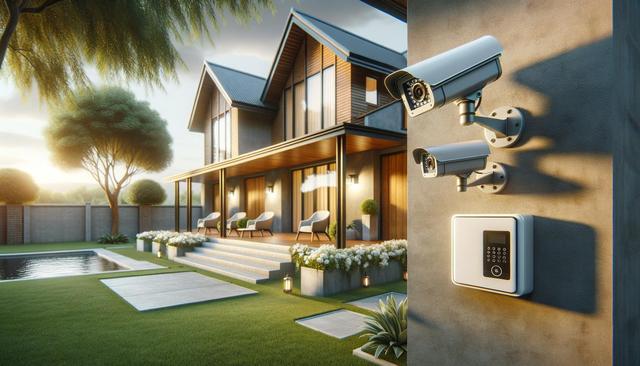
A Practical Guide to Home Security Systems
Understanding the Basics of Home Security Systems
Home security systems are designed to detect, deter, and respond to unauthorized entry or suspicious activity around your property. They often consist of multiple components working together to provide comprehensive protection, including sensors, control panels, cameras, and alarms. Whether you live in a small apartment or a multi-story home, understanding the core elements of a security system is the first step toward making an informed choice. Key features typically include door and window sensors, motion detectors, and sometimes environmental monitors for smoke or carbon monoxide detection. These devices communicate with a central hub or app, allowing homeowners to monitor their property in real-time.
Modern systems are increasingly wireless, which simplifies installation and allows for greater flexibility in placement. Wireless technology also makes it easier to integrate other smart home devices, such as lighting, thermostats, and voice assistants, creating a more cohesive living environment. Some systems offer professional monitoring services, while others are DIY setups that send alerts directly to your smartphone. Choosing between these options depends on your budget, lifestyle, and desired level of control.
Types of Security Systems and Their Key Components
There are several types of home security systems available, each catering to different needs and preferences. The most common types include:
- Monitored Systems: Connected to a professional monitoring service that responds to alarms and contacts emergency services if necessary.
- Unmonitored Systems: Trigger alarms or notifications without involving a monitoring center, often relying on the homeowner to take action.
- Wireless Systems: Utilize Wi-Fi or cellular networks to connect components and are ideal for renters or homes with minimal wiring infrastructure.
- Wired Systems: Typically found in older homes or custom installations, these systems rely on physical wiring for communication and power.
Core components of any system usually include a control panel, motion detectors, door/window sensors, surveillance cameras, and alarms or sirens. Some advanced systems also offer smart locks, video doorbells, and integration with mobile apps for remote access. When selecting components, it’s important to consider the size of your home, the number of entry points, and your daily routines to ensure complete coverage.
The Role of Technology in Modern Security Solutions
Technology plays a significant role in shaping the functionality and convenience of today’s home security systems. Cloud-based storage, mobile app integration, and artificial intelligence are just a few innovations that have improved the way these systems operate. For example, many modern systems allow homeowners to view live camera feeds, receive instant alerts, and control settings remotely via their smartphones or tablets. This not only enhances peace of mind but also empowers users to respond quickly to potential threats.
Artificial intelligence and machine learning are now being used to distinguish between routine activity and suspicious behavior, reducing the number of false alarms. Some cameras can recognize familiar faces or detect unusual movements and notify the user accordingly. Additionally, integration with voice-activated assistants and smart home platforms has made managing home security systems more intuitive and hands-free.
Another notable advancement is geofencing, which uses smartphone location data to automate system settings. For instance, your system can automatically arm when you leave the house and disarm upon your return. These features contribute to a seamless and adaptive security experience tailored to each household’s needs.
Cost Considerations and Budget Planning
Investing in a home security system involves both upfront and ongoing costs, which vary based on the complexity of the system and service options. Entry-level DIY kits are generally more affordable and may include basic sensors and limited camera coverage. On the other hand, professionally installed systems with monitoring services and advanced features can be more expensive, but often provide added convenience and reliability.
When budgeting, it’s essential to factor in the following costs:
- Equipment costs: Vary depending on the number and type of devices you need.
- Installation fees: May apply for professionally installed systems.
- Monitoring fees: Monthly charges for 24/7 professional monitoring services.
- Maintenance: Occasional costs for battery replacements or system updates.
Many providers offer flexible payment plans or leasing options, which can help spread out the costs over time. Additionally, some insurance companies offer discounts for homes equipped with certified security systems, which can provide long-term savings. By carefully evaluating your needs and comparing offerings, you can find a solution that aligns with both your security goals and your budget.
Tips for Choosing the Right System for Your Home
Selecting the right home security system involves more than just comparing prices. It requires a thoughtful assessment of your household’s specific needs, lifestyle, and future plans. Begin by identifying the most vulnerable areas of your home, such as entry doors, ground-level windows, and detached structures like garages or sheds. Consider how often you’re home, your comfort level with technology, and whether you prefer professional installation or a DIY approach.
Here are a few tips to guide your decision:
- Assess your home layout: Larger homes may need more sensors and cameras for full coverage.
- Consider scalability: Choose a system that allows you to add components over time as your needs evolve.
- Check compatibility: Ensure the system works with your existing devices or future smart home upgrades.
- Evaluate customer support: Quality technical support and user-friendly resources can make a big difference in your experience.
- Read reviews: Look for well-regarded systems with positive user feedback regarding reliability and ease of use.
Making a checklist of your criteria and comparing different systems based on those factors can help simplify the selection process. Whether your focus is on affordability, advanced features, or ease of use, there’s likely a system available that meets your expectations without overcomplicating your daily routine.
Conclusion: Securing Peace of Mind at Home
Home security systems offer a practical and reliable way to protect your property and enhance your sense of safety. With a wide range of options now available, homeowners can choose systems tailored to their specific needs, budget, and lifestyle. From basic sensor kits to comprehensive smart home integrations, today’s systems provide flexible solutions backed by evolving technology. By understanding how these systems work and carefully evaluating your options, you can make informed decisions that contribute to a safer, more secure home environment.


